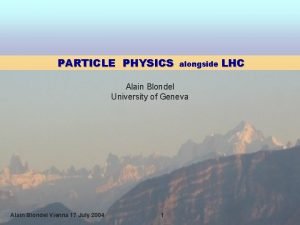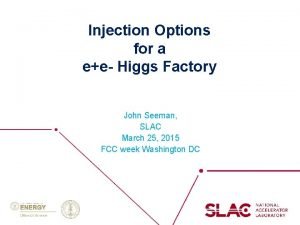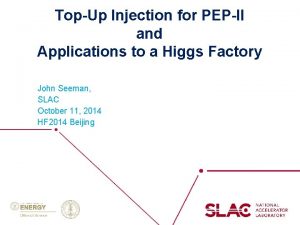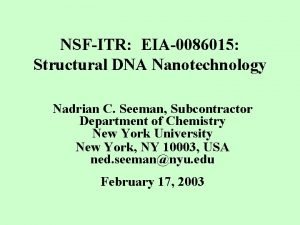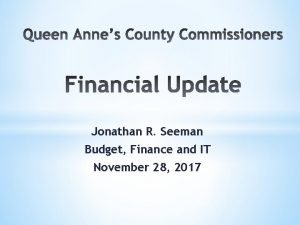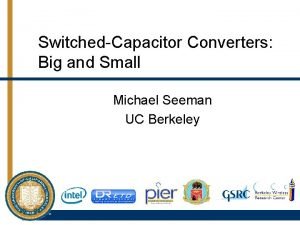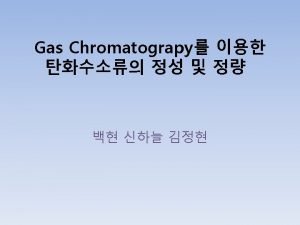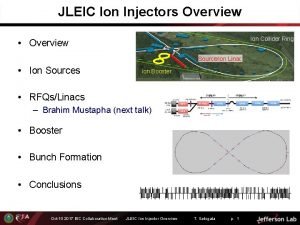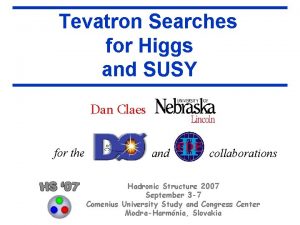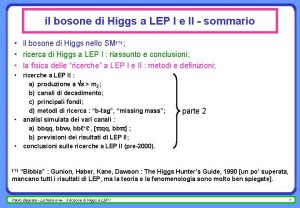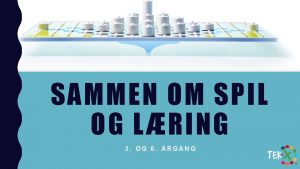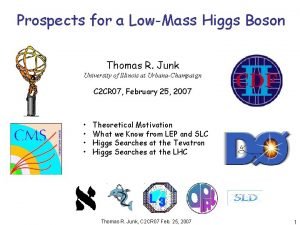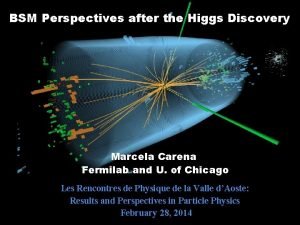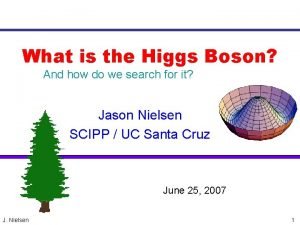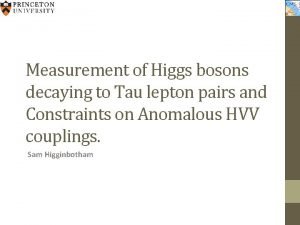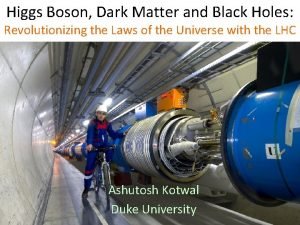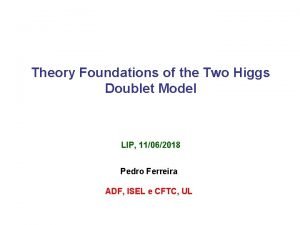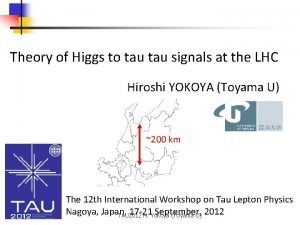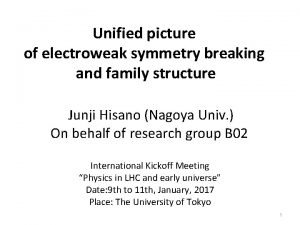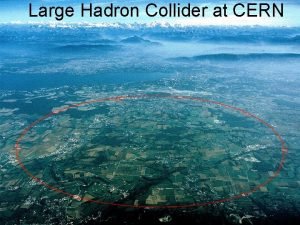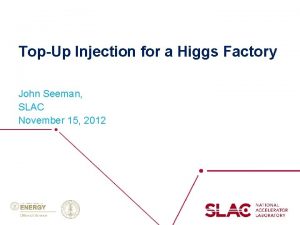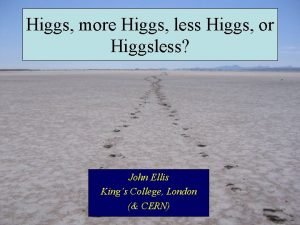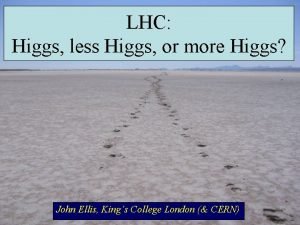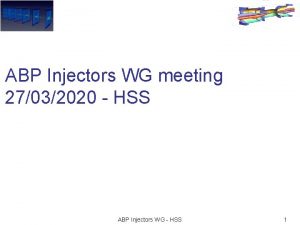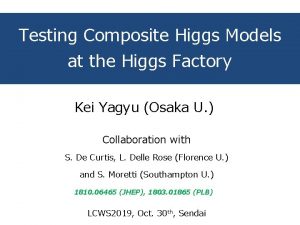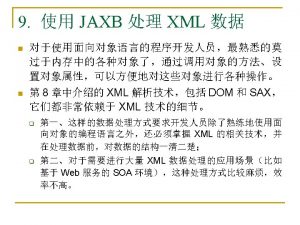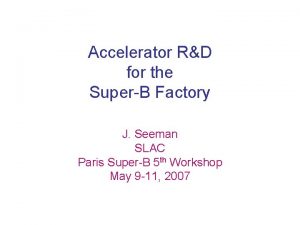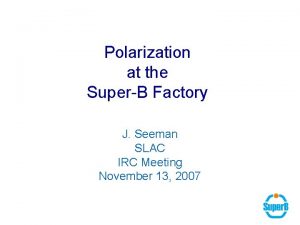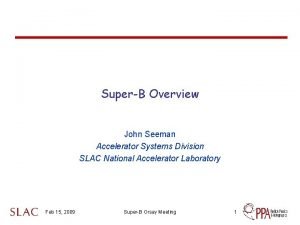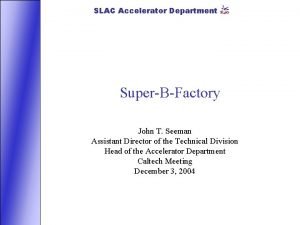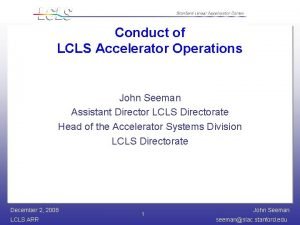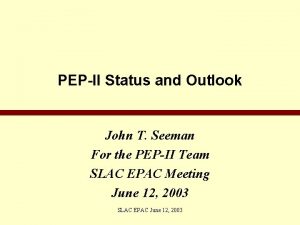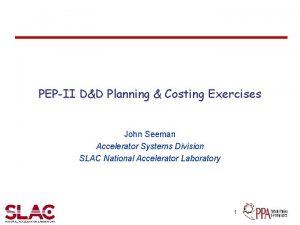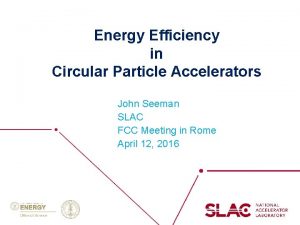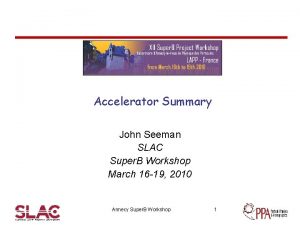Alternate Injectors for a Higgs Factory John Seeman






















![What is Next for [CEPC/FCCee] Injector Design using PWFA or DWA Optimize number of What is Next for [CEPC/FCCee] Injector Design using PWFA or DWA Optimize number of](https://slidetodoc.com/presentation_image_h/823b4c953ff7f4caf02062778386b985/image-23.jpg)













- Slides: 36

Alternate Injectors for a Higgs Factory John Seeman SLAC National Accelerator Laboratory November 7, 2017 CEPC-Spp. C Workshop

Topics Present CEPC and FCCee Injectors Layouts Generic injection requirements Alternate Injection Possibilities Basic cost scaling Design of a full energy PWFA or DWFA Injector Proposed FACET-II two-stage Wakefield Test Module 2

Part 1: CEPC Tunnel Layout Showing Booster Location Injection Lines 3

CEPC CDR Parameters showing Main Injection Requirements 4

FCCee Injector Complex e+ target DR 5

FCCee Collider Parameters (K. Oide, F. Zimmermann …) Injection issues 6

CEPC Injection Requirements (Linac into Booster) 7

Booster Ring Injector is a Serious Accelerator! The 100 km booster is a large accelerator with some complicated technologies but overall is mostly conservative. Issues include : 100 km of complex accelerator components The booster has more than 2. 2 to 10 Ge. V of SC RF at high power with significant HOMs. Vacuum chamber issues are modest (SR, eddy currents, heat expansion). Low field dipole magnet strength (~60 gauss) has issues at 6 -10 Ge. V but fewer at 20 Ge. V. Tunnel interferences with collider components (e. g. SCRF, detectors, cryo-distribution) Potential unintended cross talk to e+e- or pp colliders including radiation. Beam instabilities at 6 -10 Ge. V could spray radiation on the other accelerators and hardware. High cost at 100 km. 8

Parametric Cost Analysis The plan is to provide an average parametric cost value for each segment of the injector chain. The costs are split into “tunnel” and “accelerator” costs. A cost value per meter were be assigned depending on the difficulty of the technology. For example, a linac costs more per meter than a transport line. Curved transport more than straight. SC linac is more than Cu. A linac tunnel cost more per meter than a transport line tunnel because of waveguides, klystrons, and modulators. When an accelerator shares a tunnel with another accelerator, the main accelerator get the cost of the tunnel and only the incremental costs for the tunnel will be added to the lesser one. The cost is then calculated by the cost per meter times the length of the accelerator segment. The cost values are only for comparisons of different technologies and do not represent the actual real costs which is more complicated to calculate. 9

Various 125 -175 Ge. V Injector Types Compared (Parametric) Base injector at 100 Hz: (=6 Ge. V linac+DR+gun+target+injection into the collider rings) (same for all and not included) Relative parametric cost Booster (FCCee) (baseline)(175 Ge. V) 1. 0 (Nominal) Booster (CEPC)(baseline) (125 Ge. V) 0. 9 Full Energy Cu linac (175) 1. 2 e- Beam Plasma Wake Field Accelerator PWFA (175) 0. 4 e- Beam Dielectric Wake Accelerator DWA (175) 0. 38 Laser Wake Field Accelerator LWFA (175) 30. 0 e- CLIC (classic) style linac (175) 0. 7 Awake (proton driver) PWFA Need ~100 SPSs for 100 Hz rate with 10 bpp 10

Hogan: SLAC Linear Collider Concept in 2014 using PWFA 11

SLAC FACET has accelerated both e- and e+ Electrons Positrons (Hollow plasma) Achieved parameters: 12

Dielectric Wake Accelerator (O’Shea) Hollow ceramic tubes with metal outer jacket. If a= 150 microns and b = 200 microns = 2. 8 Ge. V/m If a= 225 microns and b = 320= microns = 1. 0 Ge. V/m 13

DWA Parameters Achieved (~2005) Need 15 to 30 m long cells to reach 30 Ge. V gain 14

PWFA and DWA Injector (Simplified) Electrons: Make six bunches longitudinally placed at 30 Ge. V each from a low emittance gun at a few x 1010 e- each 1. 6 m (5. 7 nsec) bunch separation longitudinally One witness (injected bunch per cycle into CEPC/FCCee) and five drive bunches Positrons: e+ bunch from the damping ring accelerated to 30 Ge. V Make five e- bunches at 30 Ge. V each a few x 1010 One e+ witness (injected bunch into CEPC/FCCee) and five drive bunches Lasers: Only pre-ionize gas with lasers with no energy put into the beam. (perhaps could do without. ) Acceleration scheme: Five PWFA or DWA cells at 30 Ge. V each to reach 180 Ge. V, per beam 15

Schematic of Beam PWFA or DWA Injector (Not Optimized) One Linac makes a witness bunch and several drive bunches (~5) longitudinally and then sequentially use then to accelerate the witness bunch by 30 Ge. V per PWFA or DWA cells to get to 175 (180) Ge. V. Need to longitudinal (phase) slip the drive bunches so that all will catch up with the “witness” bunch that gets accelerated and ultimately injected into one of the main rings. Need longitudinal distance slips of 1. 0 m to 1. 5 m (bunch spacing) which is about the distance between acceptable, with reduced transverse wakes, linac buckets. Dz = q * Dr for example Dz = 1 m and Dr = 1 m q = 1 rad Option 1: Do the phase slipping in the CEPC/FCCee main ring tunnel: then Dz ~ 16, 000 m. Way too long! Option 2: Do the phase slipping in a separate tunnel r = 280 m (like SLAC SLC), q = p for Dr = 0. 5 m gives Dz = 1. 57 m , Length ~ 879 m. Perfect! Emittance growth at 30 Ge. V is small with SLC style lattice. 16

PWFA or DWA Overview 1. 4 km 175 Ge. V e- Main FCCee Ring Straights 175 Ge. V e+ Plasma cells or DWA cells 280 m radius … ~500 m 6 total arcs 0. 5 m apart 6 total arcs 0. 5 m apart … e- arcs e+ and e- drive arcs e+ one bunch e- 5 bunches e- 6 bunches Bunch compress in arcs. Kicker is a linear ramp. Linac (30 Ge. V) 17

Design very similar to the SLAC SLC Arcs (1988 -1998) 280 m radius Beam 18

SLAC SLC Arc Installation 19

Optimum Number of Arcs (Bunches) Ef = E 0 + n DEc Ef = final energy = 175 to 180 Ge. V E 0 = linac energy DEc = PWFA cell incremental energy n = number of PWFA cells n+1 = number of arc transport lines (each side) E 0 (Ge. V) (Linac) n DEc (Ge. V) (PWFA) 44 35 30 25 6 25 22 7 22 20

Accelerating Cells For PWFA length: 3 x 1016 plasma density, 3 m long 30 Ge. V each For DWA: If a= 200 microns (radius) and b = 300= microns = 1. 0 Ge. V/m 30 m 30 Ge. V (It will be shorter if smaller diameter. ) Advantage: Beam sees no direct material. 21

Rough Hardware of a PWFA/DWFA Injector Need more Cu linac over base linac = 24 Ge. V (30 -6 Ge. V): Need to build 12 transport lines (six per side): 12 lines x 1100 m/line =13 km Need to build 10 Plasma or DWA cells (5 per side) 22
![What is Next for CEPCFCCee Injector Design using PWFA or DWA Optimize number of What is Next for [CEPC/FCCee] Injector Design using PWFA or DWA Optimize number of](https://slidetodoc.com/presentation_image_h/823b4c953ff7f4caf02062778386b985/image-23.jpg)
What is Next for [CEPC/FCCee] Injector Design using PWFA or DWA Optimize number of cells. Linac parameters to make 6 (or n) good bunches. Bunch length manipulation. Define arc layout. Define optics entering and leaving the plasma and dielectric cells. Beam tolerances in transport and accelerating cells. 23

An Aside: Why a PWFA or DWA Injector? Large overall cost savings are expected for CEPC/FCCee if this injector works! However, the big view: Jumping into a full 1 Te. V scale linear collider using PWFA or DWA is a very big step from the present status. Many technologies have to work. Need to prove the basic technologies are viable and reliable. A 125 -175 injector for CEPC/FCCee with less stringent parameters would be an excellent first step. Most of the technologies will then be proven for a high energy linac collider. First Test at FACET-II! 24

(New) Proposed Beam Test of a two stage PWFA (+DWA) at SLAC First: Complete FACET-II. Next: Add a two stage PWFA (and/or DWA) experiment modules. Try for 30 Ge. V result starting from 10 Ge. V bunches at 30 Hz. Plan: Make two e- bunches (both with 3 x 1010) in the linac spaced 5. 7 nsec (1. 76 m) apart. First bunch self accelerates its tail (witness) in first plasma cell (few x 109) from 10 to 20 Ge. V. Second bunch accelerates the same witness bunch to 30 Ge. V in second plasma cell. Measure properties of 30 Ge. V final witness beam. 25

Goal: Test Beam Parameters similar to CEPC/FCCee Two PWFA or DWA stages: 10 Ge. V start + 2 x 10 Ge. V cells = 30 Ge. V (final) Goal for output beam parameters (needed for CEPC/FCCee): 30 Hz 30 Ge. V Charge per exiting bunch ~ 6 x 109 Charge stability < 2% Bunch length < 2 mm Energy spread rms < 0. 5 % Emittance (x, y) < 10 nm-rad Energy stability < 1 % Transformer ratio =1. 0+ 26

Transverse wakes in SLAC Cu linac for the two bunches Longitudinal: The longitudinal wakes are compensated by running the bunches in the Cu linac slightly off crest in the SLED pulse as was done in the SLC. Besides, if the three bunches have somewhat different energies in Sector 20 they can be compensated by adjusting the three transport lines. Different energies may help with transverse wakes. Tranverse: Karl Bane has calculated the transverse wakes following a leading bunch. SLAC-PUB-14608 (Dec. 2011). Concluded that 5 nsec spacing is the best. 2. 5 nsec worst. Decker and Sheppard have been studying transverse wakes with two LCLS bunches at 150 p. C. Concluded that with carefully adjusted linac transverse bumps, the linac transverse bunches can be compensated with any bunch spacing at 150 p. C. (Similar to what Seeman and Decker did for the SLC in ~1990. ) If these do not work then fall back to only 2 drive bunches spaced by 5 nsec or reduce bunch charges. Plotted (early) path difference is 1. 76 m which is 5. 86 nsec. Good distance. 27

Rough Layout of SLAC Linac showing FACET-II Area PWFA-DWA test will happen here, if approved. FACET-II 28

Schematic horizontal trajectories of two bunches (plan view) 1 = linac straight beam 2 = second bunch = plasma cell Plasma cell A B FACET Final Focus 2 1 Plasma cell 29

Six present beam lines in Sector 20 at “A” 30

Sector 20 Adit in the tunnel at “B” FACET-II Extraction line to positron source 31

MATLAB: Exact FACET Area including Two Beam Lines Diagnostics Path difference in code = 1. 76 m DL 12 can be adjusted precisely by component placement. 32

One kicker will change trajectories of second drive bunch 5. 7 nsec Kicker for trailing bunch Present kicker has ~25 nsec rise time. 33

2 nsec Fast kicker (A. Krasnykh et al, SLAC) 34

SLAC FACET-II PWFA/DWA Test: Future work if approved: PWFA: Find the optimum plasma cell parameters. Arrange plasma/drive parameters to make small witness energy spread. Beams: Fine tune beam lines 1 and 2 for paths to the correct length to about 10 microns and be able to tune to these values. Make beam optics for all beam line transitions to and from plasma cells. Determine if dipole bends (use segments of SLC arc magnets) can preserve emittances Investigate tolerance in beam transport (SR, CSR, …) Work out drive beam dumps. Work out the longitudinal beam loading and linac RF phases in the Cu linac. Plasma cell parameters See if linac bumps can fix transverse wakes in Cu linac at 5. 6 nsec. Can the FACET-II gun make two 2 -4 x 1010 bunches? Make a full scale 4 nsec rise time fast kicker. 35

Thanks for your attention Inputs from: K. Bane, J. Sheppard, F-J. Decker (SLAC linac wakes) X. Cui (CEPC Injection) W. Chou, J. Gao (CEPC) M. Hogan (PWFA) S. Ogur, K. Oide, F. Zimmermann (FCC, injection, costs) B. O’Shea (DWFA) 36
 Higgs factory
Higgs factory Higgs factory
Higgs factory Scence
Scence Java factory factory joke
Java factory factory joke Nadrian c. seeman
Nadrian c. seeman Jonathan seeman
Jonathan seeman Michael seeman
Michael seeman Splitless injector
Splitless injector Premco injectors
Premco injectors Ion injectors
Ion injectors Mix rite
Mix rite Higgs
Higgs Higgs singlet
Higgs singlet Bosone di higgs
Bosone di higgs Hungry higgs
Hungry higgs Higgs boson
Higgs boson Higgs singlet
Higgs singlet Higgs boson
Higgs boson Higgs
Higgs Higgs boson black hole
Higgs boson black hole Higgs doublet
Higgs doublet Higgs to tau tau
Higgs to tau tau Higgs singlet
Higgs singlet Playfer
Playfer Chelsea higgs wise
Chelsea higgs wise Myndigheten för delaktighet
Myndigheten för delaktighet Presentera för publik crossboss
Presentera för publik crossboss Klassificeringsstruktur för kommunala verksamheter
Klassificeringsstruktur för kommunala verksamheter Tack för att ni lyssnade
Tack för att ni lyssnade Tes debattartikel
Tes debattartikel Tack för att ni lyssnade bild
Tack för att ni lyssnade bild En lathund för arbete med kontinuitetshantering
En lathund för arbete med kontinuitetshantering Tobinskatten för och nackdelar
Tobinskatten för och nackdelar Mall för referat
Mall för referat Tack för att ni har lyssnat
Tack för att ni har lyssnat Vanlig celldelning
Vanlig celldelning Lågenergihus nyproduktion
Lågenergihus nyproduktion
